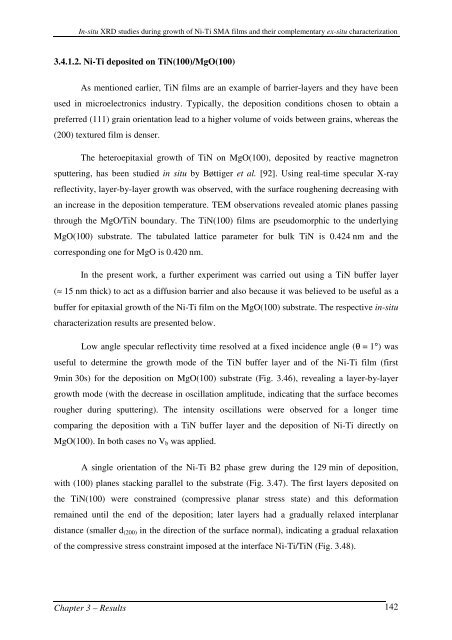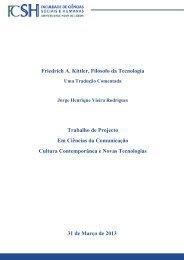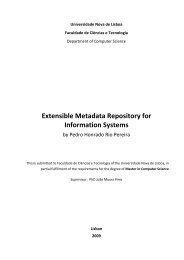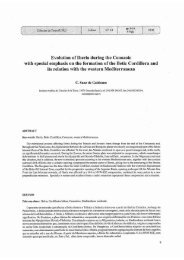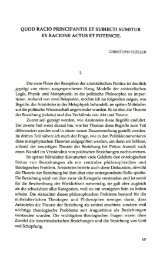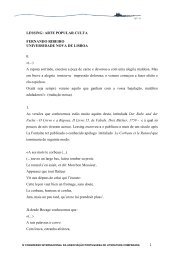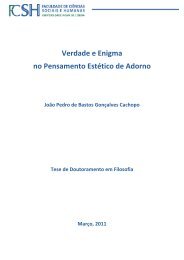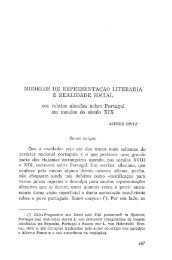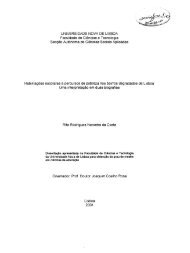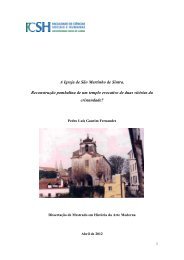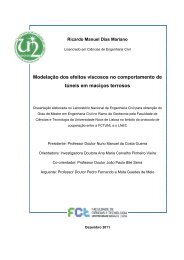PhD Thesis_RuiMSMartins.pdf - RUN UNL
PhD Thesis_RuiMSMartins.pdf - RUN UNL
PhD Thesis_RuiMSMartins.pdf - RUN UNL
You also want an ePaper? Increase the reach of your titles
YUMPU automatically turns print PDFs into web optimized ePapers that Google loves.
In-situ XRD studies during growth of Ni-Ti SMA films and their complementary ex-situ characterization<br />
3.4.1.2. Ni-Ti deposited on TiN(100)/MgO(100)<br />
As mentioned earlier, TiN films are an example of barrier-layers and they have been<br />
used in microelectronics industry. Typically, the deposition conditions chosen to obtain a<br />
preferred (111) grain orientation lead to a higher volume of voids between grains, whereas the<br />
(200) textured film is denser.<br />
The heteroepitaxial growth of TiN on MgO(100), deposited by reactive magnetron<br />
sputtering, has been studied in situ by Bøttiger et al. [92]. Using real-time specular X-ray<br />
reflectivity, layer-by-layer growth was observed, with the surface roughening decreasing with<br />
an increase in the deposition temperature. TEM observations revealed atomic planes passing<br />
through the MgO/TiN boundary. The TiN(100) films are pseudomorphic to the underlying<br />
MgO(100) substrate. The tabulated lattice parameter for bulk TiN is 0.424 nm and the<br />
corresponding one for MgO is 0.420 nm.<br />
In the present work, a further experiment was carried out using a TiN buffer layer<br />
(≈ 15 nm thick) to act as a diffusion barrier and also because it was believed to be useful as a<br />
buffer for epitaxial growth of the Ni-Ti film on the MgO(100) substrate. The respective in-situ<br />
characterization results are presented below.<br />
Low angle specular reflectivity time resolved at a fixed incidence angle (θ = 1°) was<br />
useful to determine the growth mode of the TiN buffer layer and of the Ni-Ti film (first<br />
9min 30s) for the deposition on MgO(100) substrate (Fig. 3.46), revealing a layer-by-layer<br />
growth mode (with the decrease in oscillation amplitude, indicating that the surface becomes<br />
rougher during sputtering). The intensity oscillations were observed for a longer time<br />
comparing the deposition with a TiN buffer layer and the deposition of Ni-Ti directly on<br />
MgO(100). In both cases no V b was applied.<br />
A single orientation of the Ni-Ti B2 phase grew during the 129 min of deposition,<br />
with (100) planes stacking parallel to the substrate (Fig. 3.47). The first layers deposited on<br />
the TiN(100) were constrained (compressive planar stress state) and this deformation<br />
remained until the end of the deposition; later layers had a gradually relaxed interplanar<br />
distance (smaller d (200) in the direction of the surface normal), indicating a gradual relaxation<br />
of the compressive stress constraint imposed at the interface Ni-Ti/TiN (Fig. 3.48).<br />
Chapter 3 – Results 142


